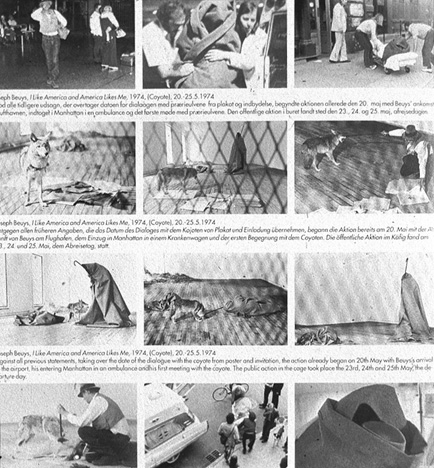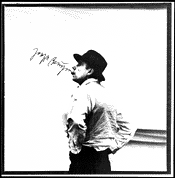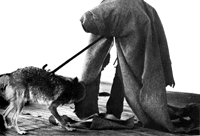|
|
JOSEPH
BEUYS:A BRIEF BIOGRAPHY Joseph Beuys was born in 1921 in Krefeld, a city in northwestern Germany near the Dutch border. He grew up in the nearby towns of Kleve and Rindern, the only child in a middle class, strongly Catholic family. During his youth he pursued dual interests in the natural sciences and art, and he chose a career in medicine. In 1940 he joined the military, volunteering in order to avoid the draft. He was trained as an aircraft radio operator and combat pilot, and during his years of active duty he was seriously wounded numerous times. At the end of the war he was held in a British prisoner-of-war camp for several months, and returned to Kleve in 1945. Coming to terms with his involvement in the war was a long process and figures, at least obliquely, in much of his artwork. Beuys often said that his interest in fat and felt as sculptural materials grew out of a wartime experience--a plane crash in the Crimea, after which he was rescued by nomadic Tartars who rubbed him with fat and wrapped him in felt to heal and warm his body. While the story appears to have little grounding in real events (Beuys himself downplayed its importance in a 1980 interview), its poetics are strong enough to have made the story one of the most enduring aspects of his mythic biography. On his return from the war Beuys abandoned his plans for a career in medicine and enrolled in the Düsseldorf Academy of Art to study sculpture. He graduated in 1952, and during the next years focused on drawing--he produced thousands during the 1950s alone--and reading, ranging freely through philosophy, science, poetry, literature, and the occult. He married in 1959 and two years later, at the age of 40, was appointed to a professorship at his alma mater. During the early 1960s, Düsseldorf developed into an important center for contemporary art and Beuys became acquainted with the experimental work of artists such as Nam June Paik and the Fluxus group, whose public "concerts" brought a new fluidity to the boundaries between literature, music, visual art, performance, and everyday life. Their ideas were a catalyst for Beuys' own performances, which he called "actions," and his evolving ideas about how art could play a wider role in society. He began to publicly exhibit his large-scale sculptures, small objects, drawings, and room installations. He also created numerous actions and began making editioned objects and prints called multiples. As the decades advanced, his commitment to political reform increased and he was involved in the founding of several activist groups: in 1967, the German Student Party, whose platform included worldwide disarmament and educational reform; in 1970, the Organization for Direct Democracy by Referendum, which proposed increased political power for individuals; and in 1972, the Free International University, which emphasized the creative potential in all human beings and advocated cross-pollination of ideas across disciplines. In 1979 he was one of 500 founding members of the Green Party. His charismatic presence, his urgent and public calls for reform of all kinds, and his unconventional artistic style (incorporating ritualized movement and sound, and materials such as fat, felt, earth, honey, blood, and even dead animals) gained him international notoriety during these decades, but it also cost him his job. Beuys was dismissed in 1972 from his teaching position over his insistence that admission to the art school be open to anyone who wished to study there. While he counted debate, discussion, and teaching as part of his expanded definition of art, Beuys also continued to make objects, installations, multiples, and performances. His reputation in the international art world solidified after a 1979 retrospective at New York's Guggenheim Museum, and he lived the last years of his life at a hectic pace, participating in dozens of exhibitions and traveling widely on behalf of his organizations. Beuys died in 1986 in Düsseldorf. In the subsequent decade his students have carried on his campaign for change, and his ideas and artwork have continued to spark lively debate. -Joan Rothfuss, Walker Art Center curator |

|
ACTIONS Joseph Beuys viewed performance art as a medium with the potential for self healing and social transformation. He believed that by enacting self-invented rituals, he could assume the role of a modern-day shaman and affect the world around him. His performances, or "actions," utilized elements of the absurd and contained layers of meanings and symbols. But even within a seemingly chaotic environment, Beuys attempted to create an atmosphere for his viewer that would unite the intuitive, passionate soul with the intellectual mind, and thus prepare the individual for a spiritual evolution. Beuys created and carried out 70 actions between 1963 and 1986, the year of his death. During this time, he also created approximately 50 installations, participated in more than 130 solo exhibitions, and conducted numerous interviews, seminars, lectures, and discussions. His public persona, "Beuys the artist," was created almost immediately after his first public performance and soon became indistinguishable from "Beuys the man." He wore a signature costume of jeans, felt hat, and fishing vest, both onstage and off, and repeatedly used certain materials in his work, such as fat and felt, which referenced his earlier life and wartime experience. "The whole process of living is my creative act," he said. Beuys was introduced to performance art in 1962 when he encountered Fluxus, a nonconformist international group of artists who sought to upset bourgeois perceptions of art and life. Fluxus included fellow artists George Maciunas, Nam June Paik, John Cage, George Brecht, Robert Filliou, Dick Higgins, Alison Knowles, Yoko Ono, Ben Patterson, Daniel Spoerri, Wolf Vostell, and Emmett Williams. According to Erwin Heerich, a friend of Beuys, "The contact with Fluxus endowed the issue of art and life, in Beuys' mind, with a radically different significance. In Fluxus he recognized a vital current that released new impulses in himself--and here the other side of Beuys emerged, his powerful sensitivity to, and talent for, the public arena and the media." In 1963 Beuys invited Fluxus artists to perform at the Düsseldorf Academy of Art. Brecht, Maciunas, Paik, Vostell, and Williams participated, and Beuys performed his first two public actions, Composition for 2 Musicians and Siberian Symphony, 1st Movement. Beuys' actions were often described as intimate, autobiographical, politically charged, and intense. Actions would typically last 45 minutes to nine hours, and though his actions were not rehearsed, Beuys often created a score or "partitur" (as opposed to a script) in which he would plan the objects that would be used and the sequence of the performance. Beuys viewed each action as a new version of a basic theme and an attempt to make his philosophy more comprehensible. He also believed that the less literal the performances were, the easier it would be for the audience members to translate his message into their own lives. Beuys traveled to the United States in 1974 and performed an action entitled I like America and America Likes Me at the René Block Gallery in New York. The action actually began at Kennedy Airport, where friends wrapped him in felt and transported him to the gallery in an ambulance. Beuys then spent several days in a room with only a felt blanket, a flashlight, a cane that looked like a shepherd's staff, copies of the Wall Street Journal (which were delivered daily), and a live coyote. His choice of employing a coyote was perhaps an acknowledgment of an animal that holds great spiritual significance for Native Americans, or a commentary on a country that through its Western expansion had become "lost" America. Beginning in the mid-1970s, Beuys increasingly used his actions as a forum for his political and environmental beliefs. In 1982 he undertook his first large-scale ecological action, 7000 Oaks, for the exhibition documenta 7. Beuys planted the first of 7,000 trees on Friedrichsplatz, outside the Museum Fridericianum in Kassel. This was the very same location that he intended to plant the final tree. His plan was for the trees to be planted in the urban areas of Kassel, and next to each tree was to stand a four-foot-high basalt column. He involved the local community in the planting of trees outside schools, in playgrounds, and along city streets. By 1986, the year of Beuys' death, 5,500 trees had been planted. On June 12, 1987, at the opening of documenta 8, his son, Wenzel, completed the project by planting the 7,000th tree. Joseph Beuys repeatedly said that his art was intended to arouse in other people a "spiritual response," and it was his role to provide "the means to point out that the human being is a creative being." Perhaps he could have made his messages more clear, but for Beuys, "Art is not there to provide knowledge in direct ways. It produces deepened perceptions of experience. . . . Art is not there to be simply understood, or we would have no need of art." -Emily Rekow, Walker Art Center Department of Education and Community Programs |

